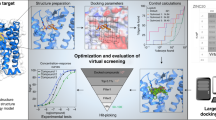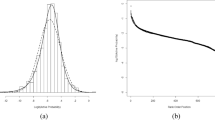Abstract
High-throughput screening (HTS) searches large libraries of chemical compounds for those that can modulate the activity of a particular biological target; it is the dominant technique used in early-stage drug discovery. A key problem in HTS is the prevalence of nonspecific or 'promiscuous' inhibitors. These molecules have peculiar properties, act on unrelated targets and can dominate the results from screening campaigns1. Several explanations have been proposed to account for promiscuous inhibitors, including chemical reactivity1,2, interference in assay read-out2, high molecular flexibility3 and hydrophobicity2,4. The diversity of these models reflects the apparently unrelated molecules whose behaviors they seek to explain. However, a single mechanism may explain the effects of many promiscuous inhibitors: some organic molecules form large colloid-like aggregates that sequester and thereby inhibit enzymes5. Hits from HTS, leads for drug discovery and even several drugs appear to act through this mechanism at micromolar concentrations5,6,7,8,9. Here, we report two rapid assays for detecting promiscuous aggregates that we tested against 1,030 'drug-like' molecules. The results from these assays were used to test two preliminary computational models of this phenomenon and as benchmarks to develop new models.
This is a preview of subscription content, access via your institution
Access options
Subscribe to this journal
Receive 12 print issues and online access
$259.00 per year
only $21.58 per issue
Buy this article
- Purchase on Springer Link
- Instant access to full article PDF
Prices may be subject to local taxes which are calculated during checkout



Similar content being viewed by others
References
Rishton, G.M. Reactive compounds and in vitro false positives in HTS. Drug Discov. Today 2, 382–384 (1997).
Walters, W.P., Ajay, A.A. & Murcko, M.A. Recognizing molecules with drug-like properties. Curr. Opin. Chem. Biol. 3, 384–387 (1999).
Veber, D.F. et al. Molecular Properties that influence the oral bioavailability of drug candidates. J. Med. Chem. 45, 2615–2623 (2002).
Roche, O. et al. Development of a virtual screening method for identification of 'frequent hitters' in compound libraries. J. Med. Chem. 45, 137–142 (2002).
McGovern, S.L., Helfand, B.T., Feng, B.Y. & Shoichet, B.K. A specific mechanism of nonspecific inhibition. J. Med. Chem. 46, 4265–4272 (2003).
Frenkel, Y.V. et al. Concentration and pH dependent aggregation of hydrophobic drug molecules and relevance to oral bioavailability. J. Med. Chem. 48, 1974–1983 (2005).
McGovern, S.L., Caselli, E., Grigorieff, N. & Shoichet, B.K. A common mechanism underlying promiscuous inhibitors from virtual and high-throughput screening. J. Med. Chem. 45, 1712–1722 (2002).
McGovern, S.L. & Shoichet, B.K. Kinase inhibitors: not just for kinases anymore. J. Med. Chem. 46, 1478–1483 (2003).
Seidler, J., McGovern, S.L., Doman, T. & Shoichet, B.K. Identification and prediction of promiscuous aggregating inhibitors among known drugs. J. Med. Chem. 46, 4477–4486 (2003).
Ryan, A.J., Gray, N.M., Lowe, P.N. & Chung, C-W. Effect of detergent on 'promiscuous' inhibitors. J. Med. Chem. 46, 3448–3451 (2003).
Lipinski, C.A., Dominy, B.W. & Feeney, P.J. Experimental and computational approaches to estimate solubility and permeability in drug discovery and development settings. Adv. Drug Deliv. Rev. 23, 3–25 (1997).
Breiman, L. Random forests. Mach. Learn. 45, 5–32 (2001).
Weston, G.S., Blazquez, J., Baquero, F. & Shoichet, B.K. Structure-based enhancement of boronic acid-based inhibitors of AmpC β-lactamase. J. Med. Chem. 41, 4577–4586 (1998).
Ghose, A.K., Viswanadham, V.M. & Wendoloski, J.J.A. Knowledge-based approach in designing combinatorial or medicinal chemistry libraries for drug discovery. 1. A qualitative and quantitative characterization of known drug databases. J. Comb. Chem. 1, 55–68 (1999).
Acknowledgements
Supported by GM71630, the QB3 fund and the Burroughs-Wellcome Fund (A.S.). We thank J. Weisman and members of the Shoichet laboratory for reading this manuscript.
Author information
Authors and Affiliations
Corresponding authors
Ethics declarations
Competing interests
The authors declare no competing financial interests.
Supplementary information
Supplementary Fig. 1
The probability-based classifier for DLS data. (PDF 247 kb)
Supplementary Fig. 2
Control data from high-throughput enzyme assay. (PDF 102 kb)
Supplementary Table 1
Interquartile ranges for common physical properties from the CMC*, and prediction and random sets selected from Chemical Diversity, Inc. (PDF 58 kb)
Supplementary Table 2
Results from low-throughput enzyme assays. (PDF 142 kb)
Supplementary Table 3
Results of low-throughput DLS testing to verify HT-DLS results. (PDF 74 kb)
Supplementary Table 4
Summary of predictive model performance. (PDF 64 kb)
Supplementary Table 5
Combined assay results for all compounds. (PDF 273 kb)
Rights and permissions
About this article
Cite this article
Feng, B., Shelat, A., Doman, T. et al. High-throughput assays for promiscuous inhibitors. Nat Chem Biol 1, 146–148 (2005). https://doi.org/10.1038/nchembio718
Received:
Accepted:
Published:
Issue Date:
DOI: https://doi.org/10.1038/nchembio718
This article is cited by
-
Molecular dynamics simulations as a guide for modulating small molecule aggregation
Journal of Computer-Aided Molecular Design (2024)
-
Discovery and evaluation of active compounds from Xuanfei Baidu formula against COVID-19 via SARS-CoV-2 Mpro
Chinese Medicine (2023)
-
Probing the free-state solution behavior of drugs and their tendencies to self-aggregate into nano-entities
Nature Protocols (2021)
-
Targeted drug delivery strategies for precision medicines
Nature Reviews Materials (2021)
-
Computationally guided high-throughput design of self-assembling drug nanoparticles
Nature Nanotechnology (2021)



